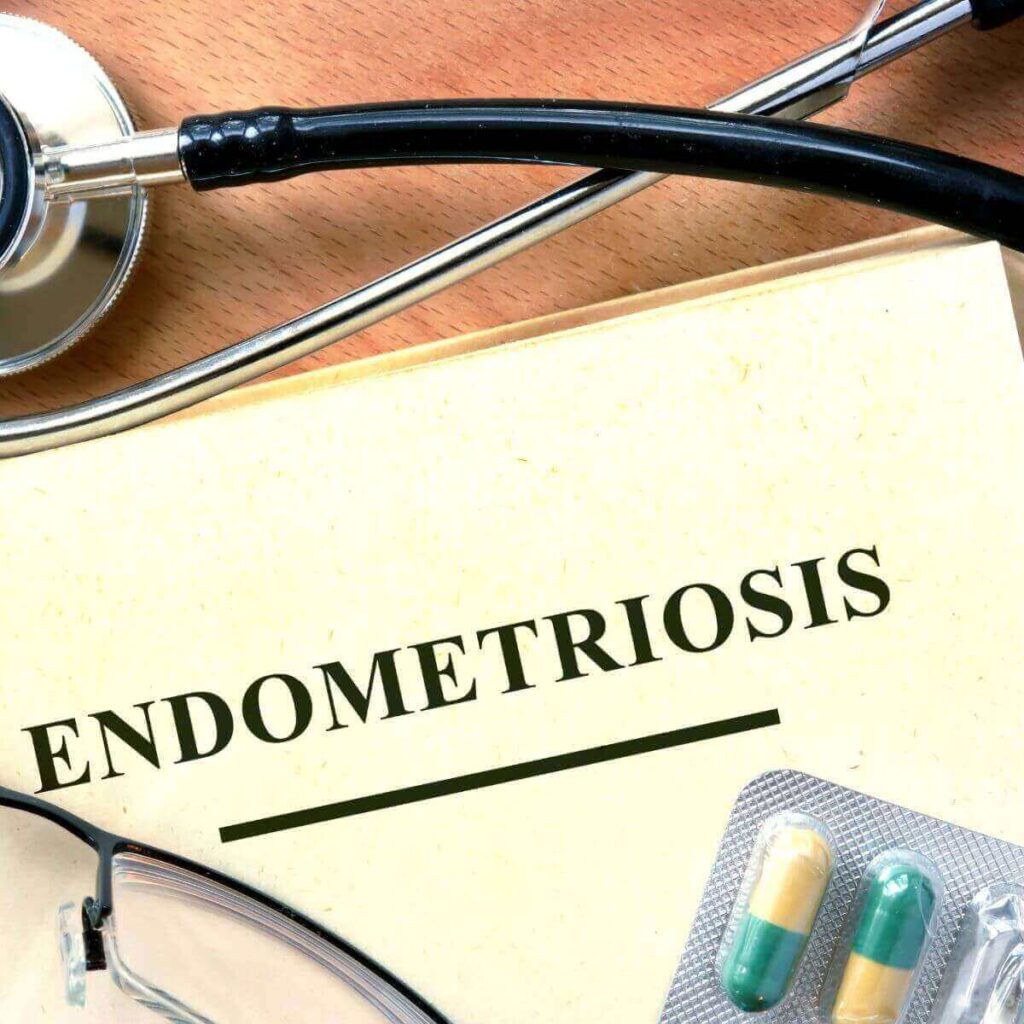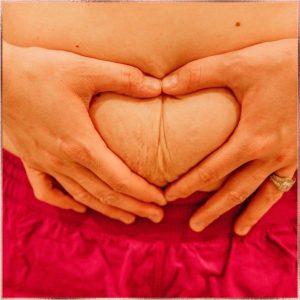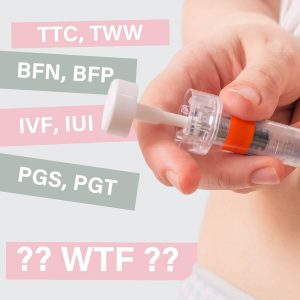I once read an article about how different people describe what endometriosis feels like. Dr. Sallie Sarrel, a pelvic physical therapist in New York and New Jersey, says this:
“…Endometriosis pain is like a gut-wrenching bomb that goes off in your insides. Its shrapnel tortures you physically, emotionally, and financially forever.”
If you’ve never experienced it, suffice it to say that endometriosis is pretty damn awful.
Now, add the fact that TTC (Trying To Conceive) with endometriosis (ENDO) can become an insurmountable challenge, and dealing with this disorder can feel downright impossible.
While I don’t have ENDO, I’ve met several people throughout my life who do. The stories I’ve heard and the pain they face are something I can’t even fathom. ENDO sufferers can be forced to live and work through excruciating symptoms on a daily, weekly, and monthly basis.
Then, as if the pain isn’t enough, the disease can make achieving a healthy pregnancy complicated and possibly even unattainable.
If you’re one of the 11% of people with endometriosis in the United States, you might feel lost about your potential to get pregnant. But when pregnancy feels like a pipe dream, you can find comfort in the fact that there ARE options.
Check out the information below to help determine what you can do to get pregnant with endometriosis.

This site contains affiliate links, meaning that we earn a small commission for purchases made through our site. We only recommend products we personally use, love, or have thoroughly vetted.
- What is Endometriosis?
- 7 Signs You Might Have This Reproductive Disease
- Does Endometriosis Cause Infertility?
- Is Endometriosis Curable? Treatable?
- What Are the Best Options for Getting Pregnant with Endometriosis?
- Make an Appointment With Your Doctor to Learn More About TTC With Endometriosis
- Getting Pregnant with Endometriosis 101: What You Need to Know
What is Endometriosis?
If you have a uterus, you’ve also got something called endometrial lining, AKA a collection of tissues that lines the interior of your uterine wall.
When you have endometriosis, however, you also have tissue lining that grows OUTSIDE your uterus into the rest of your pelvis. Usually, this affects your ovaries, fallopian tubes, and pelvic region.
This might not sound like a huge deal, but it’s actually a significant problem.
Unlike standard endometrial lining that sheds during your period, tissues formed because of endometriosis have nowhere to go. Instead, they continue to thicken, leading to irritations, scar tissue, adhesions, and sometimes cysts, known as endometriomas.
How Common is Endometriosis and Who Does it Affect?
Over 6.5 million people in the United States suffer from ENDO. It’s most common in patients between the ages of 15 and 44. People with uteruses in their 20s, 30s and 40s are more likely to receive a diagnosis since they’re often trying to start families around this time.
7 Signs You Might Have This Reproductive Disease
Let’s be honest; endometriosis or not, our periods suck. The cramping, mood swings, and bleeding are just unpleasant–there’s no denying it.
But how do you know if the pain and discomfort you’re experiencing is something more than just your normal menstrual cycle? Watch out for these seven common symptoms of endometriosis:
1. Painful Cramping Before and During Period
While mild to intense cramps are typical of PMS, endometriosis takes the phrase “painful periods” to extremes. If you have ENDO, you might notice severe cramping several days before your period begins. The cramping might continue long after you start bleeding, too.
2. Changes in Bowel Movements
Endometriosis can cause toilet trouble from both sides of the spectrum. Many of us will struggle with either constipation or, the opposite, diarrhea.
3. Increased Menstrual Bleeding
Most of us will lose 2 – 3 tablespoons of blood over 4 – 5 days during our period. If you have ENDO, however, you might bleed for longer and will likely lose twice as much blood.
4. Discomfort or Pain During Sex
Inflammation from endometriosis tissues can make it hard for ENDO sufferers to enjoy sex. If you notice your bedroom activities are starting to pose a problem, don’t hesitate to talk to your doctor. It might not be the most comfortable conversation, but it’s crucial to try and treat the issue.
5. Nausea and/or Vomiting
Did you know that intense pain can cause nausea and vomiting? Noting that, it’s not surprising that many ENDO patients also struggle with GI symptoms.
6. Fatigue
Do you have difficulty staying awake and alert during the day? Chronic fatigue and weakness are a commonality among endometriosis patients.
7. Painful Urination
Sometimes, endometrium tissue grows on and into the bladder. When this happens, it usually causes painful urination.

Does Endometriosis Cause Infertility?
There’s actually a sixth common side effect of endometriosis: infertility
Statistics show that as many as 30 – 50% of people with this reproductive disorder will also have difficulty getting pregnant.
But why?
There are several critical effects of endometriosis that make conception challenging. These are:
- Damage to Pelvic Anatomy
- Scarred or Blocked Fallopian Tubes
- Pelvic Adhesions
- Inflammation Within the Pelvic Region
- Implantation Struggles
- Poor Egg Quality
- Hormonal Imbalances
- Irregular Periods or Ovulation
- Damaged or Scarred Ovaries
If you’re diagnosed with endometriosis and are struggling to conceive, please don’t hesitate to contact your gynecologist or healthcare provider. They can help you determine if you need to make an appointment at a reproductive medicine clinic for your condition.
What Are the Chances of Natural Conception When TTC with Endometriosis?
As devastating as your symptoms of endometriosis might be, there’s no guarantee that you’ll have a hard time getting pregnant. Research shows that up to 70% of people with mild to moderate disease cases will conceive naturally within three years.
If your doctor diagnoses you with Stage 4 endometriosis, the most severe form, you will have a higher chance of infertility.
Is There a Higher Chance of Miscarriage?
So, you’ve conceived with endometriosis, and now you’re worried about maintaining a healthy, viable pregnancy. It would be understandable for you to have concerns about miscarriage.
But while studies prove an increase in the miscarriage rates of ENDO patients, the difference isn’t drastic. Research shows a 20% chance of pregnancy loss, compared to a 12% rate in people without endometriosis.
Is Endometriosis Curable? Treatable?
While there are no current cures for endometriosis; there ARE treatments.
Your doctor might suggest one or multiple treatment options to help you overcome ENDO complications.
1. Hormone Therapy
From progesterone to birth control pills, hormone therapy treatments are integral to counteract the painful effects of endometriosis.
Not only will these medications help improve the pain levels of ENDO patients, but they can also slow new tissue growth and protect against new lesions.
The one downfall, however, is that hormones can’t eliminate existing scars and adhesions.
2. Pain Medications
Your doctor may prescribe over-the-counter pain relievers, such as NSAIDs, or prescription-strength pain relievers to fight against the pain and inflammation caused by endometriosis.
3. Surgery
In severe cases, your doctor might suggest surgical treatments for ENDO. There are several options, but some of the most frequently used include the following:
- Laparoscopy: Using a small instrument with a light to see, called a laparoscope, your surgeon may remove endometrial lesions through small incisions in your abdomen. Surgical teams often use techniques like cauterization and vaporization for this process. It’s important to note that this short-term solution is usually chosen to relieve pain.
- Laparotomy: While the overall purpose of a laparotomy is similar to a laparoscopic surgery, it’s much more invasive and requires more traditional surgical techniques. Doctors generally save this process for more severe forms of endometriosis, as the recovery takes much longer.
- Hysterectomy: One controversial treatment option for endometriosis is a total hysterectomy or the removal of your uterus. While this may eliminate a significant amount of pain from the disorder, it’s crucial to understand it’s not considered a fool-proof cure or treatment. This is also a permanent decision that makes it impossible for hopeful parents to carry children.
What Are the Best Options for Getting Pregnant with Endometriosis?
Doctors primarily use many of the treatments above to manage endometriosis side effects, such as pelvic pain. Many of them can also help you get pregnant, though.
While they won’t necessarily cure your infertility, they will increase your pregnancy success rates and improve the likelihood of various reproductive technologies working to help you conceive.
If you’re TTC with endometriosis, you should find a trusted fertility specialist to guide you through your conception options. They will explain which infertility treatment options are available and help you determine which choice is best for your family.
After your provider works on treating existing adhesions and inflammation, they may suggest further reproductive procedures, such as:
1. Intrauterine Insemination (IUI)
During an IUI, your doctor will place sperm directly into your uterus using a small catheter. This is a pain-free outpatient procedure. Studies prove that IUIs are an effective way to overcome endometriosis-caused infertility.
2. In Vitro Fertilization (IVF)
When an IUI isn’t working, your fertility specialist might suggest moving on to IVF. This involves collecting your eggs in outpatient surgery and fertilizing them outside your body.
As fertilization and growth begin, your doctor will place a developing embryo directly into your uterus under the guidance of an ultrasound.
3. Donor Egg IVF
Since endometriosis can negatively impact egg quality, using your eggs might not be an option. Cases like this might require using donor eggs. Egg donation allows hopeful parents to carry their little ones and experience childbirth.

Make an Appointment With Your Doctor to Learn More About TTC With Endometriosis
Please remember that an endometriosis diagnosis is not an automatic guarantee that you’ll have a hard time getting pregnant.
But if you have a good handle on your ENDO treatments and still can’t conceive, it might be time to book an appointment with an ob-gyn or reproductive endocrinologist for fertility testing. They can help you decide whether you need further fertility support to turn your dreams of getting pregnant into a reality.
Is TTC with endometriosis something you’re concerned about? What steps have you taken in your TTC with endometriosis journey?
Getting Pregnant with Endometriosis 101: What You Need to Know
A reproductive condition where tissue grows outside of your uterus. It can lead to extreme pain and other issues, such as blocked fallopian tubes, adhesions, poor egg quality, etc.
No. While infertility is a common symptom of endometriosis, a diagnosis does not mean it’s a certainty. Often, patients with mild to moderate cases will have little to no trouble conceiving naturally.
While endometriosis can increase a person’s chances of pregnancy loss, it’s not by much more than it would be in the case of someone without the disorder.
Treatments like hormone therapy or surgery can improve your chances of getting pregnant. That said, there’s no guarantee. Many people still require additional fertility treatments, such as IUIs or IVF.










